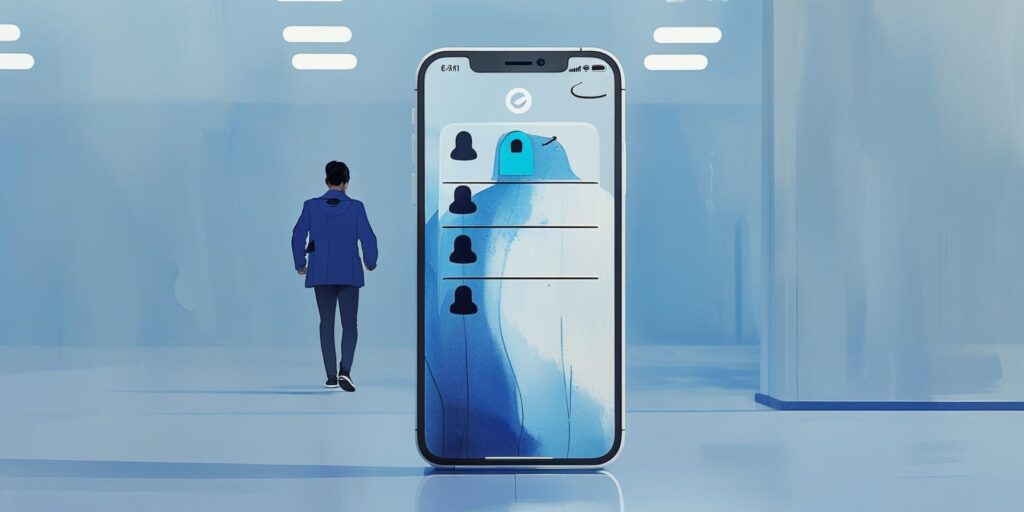Let’s be honest—your phone probably knows more about you than your best friend. It’s got your photos, banking apps, embarrassing late-night Amazon purchases, and that message thread where you complained about your boss. Now imagine losing all that to a cybercriminal while sipping coffee at an airport café in Bangkok.
Scary, right? But here’s the thing: protecting your mobile device while travelling doesn’t have to be rocket science. With some knowledge and smart precautions, you can empower yourself to keep your data safe.
Why Your Phone Becomes a Target When You Travel
You connect to the same trusted WiFi network at home daily, know your surroundings, and are generally more alert to potential scams. But travel changes everything.
Suddenly, you are tired from a long flight, rushing to catch a connection, and desperately trying to connect to any available WiFi to let your family know you’ve arrived safely. You are in unfamiliar territory, possibly dealing with language barriers, and your usual security habits might slip.
Cybercriminals know this. They specifically target travellers because we’re more vulnerable outside our comfort zones. Plus, tourist areas are goldmines for criminals—many distracted people with expensive devices are trying to stay connected.
Here’s what makes travel particularly risky:
- Public WiFi is everywhere, and most of it isn’t secure. That free airport WiFi? It’s a digital highway where anyone can see your traffic. Hotels, cafés, and train stations offer convenience but rarely security.
- You are more likely to lose your device. Between rushing through airports, navigating unfamiliar cities, and dealing with luggage, phones get forgotten, dropped, or stolen more often when travelling.
- Criminals specifically target tourists. They know you are carrying valuable devices, you might not be familiar with local scam tactics, and you are often focused on navigation or translation apps rather than security.
The Real Threats You are Facing
Let’s discuss what’s out there trying to compromise your device. Understanding these threats isn’t about creating paranoia—it’s about making informed decisions. You are not alone in facing these challenges.
The Public WiFi Trap
Public WiFi networks are like digital Main Streets—everyone can see what everyone else is doing. When you connect to an unsecured network, your data travels in plain text that anyone with basic technical knowledge can intercept.
The most common attack is a “man-in-the-middle” attack. Imagine you are trying to hand a secret note to someone across a crowded room, but instead of walking directly to them, you pass it through a line of strangers. That’s what happens with unsecured WiFi—your data passes through points where criminals can read it.
Even worse, criminals often set up fake hotspots with names like “Airport_Free_WiFi” or “Hotel_Guest_Network.” These look legitimate but are traps designed to capture your information.
The Malware Problem
Mobile malware has become incredibly sophisticated. It’s no longer just about obvious virus-like behaviour. Modern malware can quietly sit on your device, logging your keystrokes, accessing your camera, tracking your location, or stealing your authentication codes.
The most dangerous part? You might never know it’s there. Good malware is designed to be invisible while slowly harvesting your personal information. Some malware disguises itself as legitimate apps or hides within apps you’ve downloaded from official app stores.
Physical Theft and Loss
This might seem obvious, but it’s worth emphasizing: a stolen phone in the wrong hands can be devastating. Even if your device is password-protected, criminals have various methods to bypass security or extract data.
Consider this: if someone steals your unlocked phone (maybe you were using it when they grabbed it), they can access your email, banking apps, social media, and any other apps you’ve stayed logged into.
SIM Swapping: The Sneaky Attack
Here’s a threat many people don’t know about: SIM swapping. Criminals contact your mobile carrier, pretend to be you, and convince them to transfer your phone number to a SIM card they control.
This is devastating because many services use SMS for two-factor authentication. Once they have your number, they can reset passwords for your email, banking, and social media accounts. They become you in the digital world.
Your Defense Strategy: Practical Steps That Work
Now for the good news: you can significantly reduce these risks with straightforward precautions. You don’t need to become a cybersecurity expert—you need to be smart about how you use your device. These measures are effective and will give you the confidence to use your device securely.
1. Get a VPN (And Use It)
A VPN (Virtual Private Network) is like a secure tunnel for your internet connection. When you use a VPN, your data gets encrypted before it leaves your device, making it unreadable to anyone trying to intercept it.
What to look for in a VPN:
- No-logs policy (they don’t store your browsing history)
- Strong encryption (AES-256 is the gold standard)
- Fast connection speeds
- Good reputation and reviews
Avoid free VPNs. Remember: if the product is free, you are probably the product. Free VPN services often make money by selling your data or showing ads, defeating the purpose.
Pro tip: Turn on your VPN before connecting to any public WiFi, not after. Make it a habit to use a VPN first, then connect.
For ultimate peace of mind
when you travel, add Mobilen WiFi Protect to your toolkit—our cloud‑native solution encrypts every hotspot and public WiFi connection automatically. Mobilen Communications INC
2. Lock Down Your Device Properly
Your phone’s built-in security features are good—if you use them correctly.
- Enable full-device encryption. Most modern smartphones do this automatically, but check your settings to be sure. This means that even if someone gets physical access to your device, they can’t easily read your data.
- Use a strong passcode. I know—typing in a long password whenever you want to check your phone is annoying. But “1234” or your birthday isn’t going to stop a determined criminal. Use at least a 6-digit PIN, or better yet, an alphanumeric password.
- Set up biometric locks. Fingerprint and face recognition are convenient, secure, and much harder to replicate than guessing a password.
- Enable auto-lock. Set your phone to lock automatically after a short period of inactivity—30 seconds to 2 minutes is reasonable.
3. Keep Everything Updated
Those software update notifications you dismiss are not just about new features—they often include critical security patches. These patches are designed to fix vulnerabilities that cybercriminals could exploit to gain access to your device and data. So, the next time you see a software update notification, don’t ignore it-install it as soon as possible.
Cybercriminals actively look for and exploit known vulnerabilities in outdated software. When your phone manufacturer or app developer releases an update, they often fix security holes that criminals could use to access your device.
Make it easy on yourself: enable automatic updates for your operating system and apps.
4. Be Smart About WiFi
Not all WiFi networks are created equal. Here’s how to stay safer:
- Verify network names. Ask staff at hotels, cafés, or airports for the exact network name and password. Criminals often create networks with similar names (like “Hotel_WiFi” instead of “HotelGuest_WiFi”).
- Avoid sensitive activities on public WiFi. Even with a VPN, it’s better to avoid banking or shopping on public networks when possible. If you must do these activities, make sure your VPN is active.
- When you leave, forget networks. Your phone remembers WiFi networks and will automatically connect to them again. When done with them, remove public networks from your saved list.
- Turn off auto-join. Prevent your phone from automatically connecting to open networks without your permission.
5. Set Up Two-Factor Authentication (The Right Way)
Two-factor authentication (2FA) adds an extra security step beyond your password. However, not all 2FA methods are equally secure.
- Use authenticator apps, not SMS. Apps like Google Authenticator, Authy, or Microsoft Authenticator generate codes that change every 30 seconds. These are much more secure than SMS codes, which can be intercepted through SIM swapping.
- Enable 2FA on everything important. Your email, banking, social media, cloud storage—anything that contains sensitive information should have 2FA enabled.
- Have backup codes. Most services provide backup codes when you set up 2FA. Store these securely (not on your phone) if you lose access to your authenticator app.
6. Be Picky About Apps and Permissions
Every app you install is a potential entry point for attackers. Be selective and smart about what you put on your device.
- Download only from official app stores. Apple’s App Store and Google Play Store aren’t perfect, but they screen apps for obvious malware. Third-party app stores and direct downloads are much riskier.
- Review app permissions carefully. Does that flashlight app need access to your contacts and camera? Probably not. Only grant permissions that make sense for the app’s function.
Clean up unused apps. If you are not using an app, delete it. Fewer apps mean fewer potential vulnerabilities.
7. Prepare for the Worst-Case Scenario
Sometimes, despite your best efforts, things go wrong. Being prepared can minimize the damage.
- Enable device tracking. Both iPhone (“Find My”) and Android (“Find My Device”) have built-in tracking features. These let you see your device’s location on a map, make it play a sound, lock it remotely, or erase all data if necessary.
- Back up your data regularly. Use cloud services like iCloud, Google Drive, or Dropbox to automatically back up your photos, contacts, and other important data. If you lose your device, you won’t lose your memories.
- Encrypt your backups. For extra security, enable encryption for your cloud backups when available.
8. Protect Your Phone Number
SIM swapping attacks are becoming more common, so protect your phone number like you would your Social Security number.
- Set up a carrier PIN. Contact your mobile carrier and request a PIN or passphrase, which you must provide before any changes can be made to your account.
- Monitor your mobile account. Set up alerts for account changes, and check your mobile carrier account regularly for unauthorized activity.
Real-World Travel Scenarios
Let’s look at some common travel situations and how to handle them securely:
Scenario: You are at an airport and need to check your flight status
- Connect to your VPN first
- Verify the airport WiFi network name with the staff.
- Check your flight status through the airline’s official app or website.
- Log out completely when finished.
- Disconnect from the WiFi network before moving on.
Scenario: Your phone battery dies, and you need to use a public charging station
- Use your charging cable if possible.
- Consider using a USB data blocker (a small device that allows charging while blocking data transfer)
- Keep your phone locked while charging.
- Monitor it closely, and don’t walk away.
Scenario: You receive a text claiming to be from your bank about suspicious activity
- Don’t click any links in the message.
- Don’t call any of the phone numbers provided in the message.
- Instead, use the official contact information from your bank’s website.
- Verify whether the alert is legitimate before taking any action.
What to Do If Something Goes Wrong
Despite your best efforts, you might still face a security incident. Here’s how to respond:
If your device is lost or stolen:
- Use device tracking to locate it.
- If you can’t recover it, remotely lock and erase it.
- Change passwords for all important accounts.
- Contact your mobile carrier to suspend service.
- Monitor your accounts for suspicious activity.
If you suspect malware:
- Disconnect from WiFi and turn off mobile data.
- Run a security scan if you have a mobile security app.
- Uninstall recently downloaded apps.
- Change passwords for important accounts.
- Consider factory resetting your device if the problem persists.
Building Good Security Habits
The most effective security isn’t about having the perfect setup—it’s about developing good habits that become second nature. Here are some habits worth cultivating:
- Think before you connect. Consider whether you need to connect to that public WiFi network or if you can wait until you are somewhere more secure.
- Regular security check-ups. Once a month, review your app permissions, check for software updates, and clean up apps you are not using.
- Trust your instincts. It probably is if something feels suspicious—a WiFi network, an app, or a message. When in doubt, err on the side of caution.
The Bottom Line
Protecting your mobile device while travelling doesn’t have to be complicated or expensive. Most of the protection you need is already built into your device—you must activate it and use it correctly.
The key is finding the right balance between security and convenience. Yes, entering a passcode every time you use your phone is slightly annoying, and connecting to a VPN takes an extra few seconds. However, these small inconveniences are nothing compared to the potential consequences of a security breach.
Remember, criminals are looking for easy targets. By taking these basic precautions, you are making yourself a much less attractive target. Travel should be about creating memories and exploring new places—don’t let preventable security issues ruin your trip or compromise your personal information.











